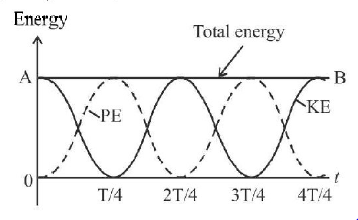Question
What do you conclude from the graph about the frequency of $$KE, PE$$ and $$SHM$$ ?
What do you conclude from the graph about the frequency of $$KE, PE$$ and $$SHM$$ ?

A.
Frequency of $$KE$$ and $$PE$$ is double the frequency of $$SHM.$$
B.
Frequency of $$KE$$ and $$PE$$ is four times the frequency $$SHM.$$
C.
Frequency of $$PE$$ is double the frequency of $$KE.$$
D.
Frequency of $$KE$$ and $$PE$$ is equal to the frequency of $$SHM.$$
Answer :
Frequency of $$KE$$ and $$PE$$ is double the frequency of $$SHM.$$
Solution :
$$KE$$ and $$PE$$ completes two vibration in a time during which $$SHM$$ completes one vibration. Thus frequency of $$PE$$ or $$KE$$ is double than that of $$SHM.$$
$$KE$$ and $$PE$$ completes two vibration in a time during which $$SHM$$ completes one vibration. Thus frequency of $$PE$$ or $$KE$$ is double than that of $$SHM.$$